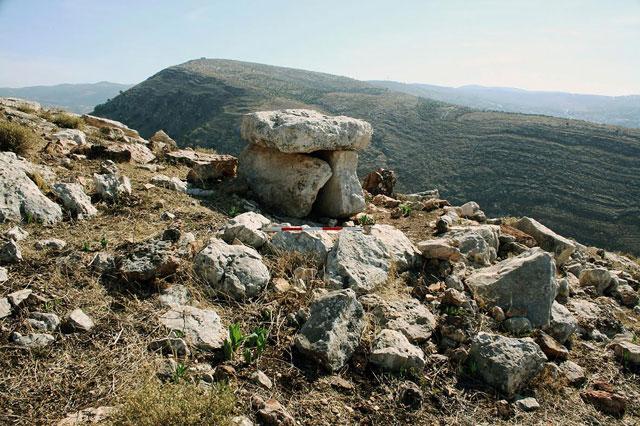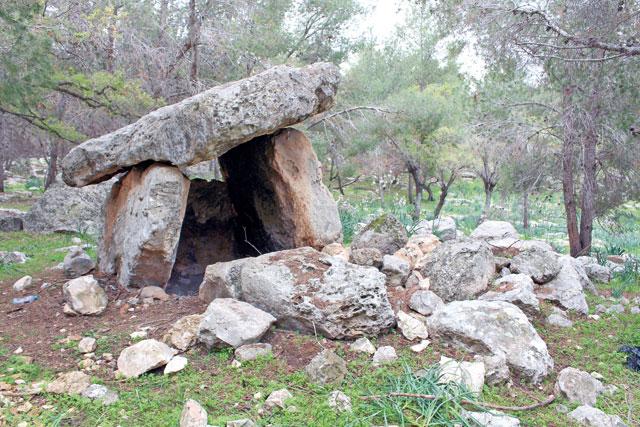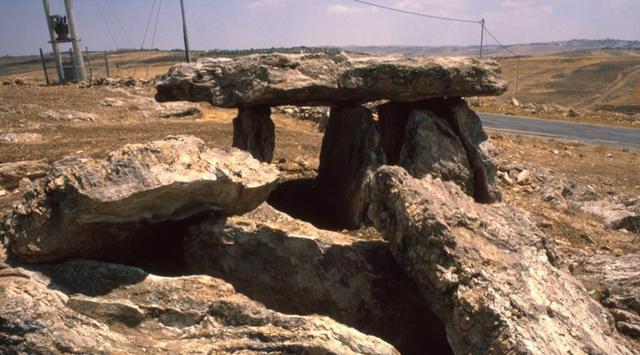You are here
Dolmens stand as ‘magnificent monuments to Jordan’s long, rich history’, scholar says
By Saeb Rawashdeh - Mar 01,2017 - Last updated at Mar 01,2017

A dolmen in Wadi Rayyan (Photo by Adam Carr/courtesy of James Fraser)
AMMAN — The monumentality of dolmens, or megalithic stone tombs, has always captured the minds of archaeologists, who find them “the most striking features in the archaeological landscape of Jordan”, according to scholar James Fraser.
The Australian was speaking during the lecture “The Visible Dead: Dolmens and the Landscape in Bronze Age Levant”, held late last month at the American Centre of Oriental Research, which presented the recent finds in fieldwork investigating dolmen cemeteries in Jordan.
Fraser, who currently runs the Khirbet Um Al Ghozlan Excavation Project for the British Museum in Wadi Rayyan, has studied dolmens and other megalithic structures as a part of the North Jordan Tomb Project, and his involvement in archaeological projects has taken him to Syria, Iraq, Afghanistan, Uzbekistan, Kashmir, Greece, Cambodia and the Solomon Islands.
The visibility of dolmens has made them an easy target for tomb raiders for the last 5,000 years, the scholar noted, adding that “archaeologists have struggled to place these mysterious monuments into their true cultural contexts”.
Scholars from the University of Sydney, of which Fraser is an alumnus, investigated a large dolmen cemetery in Wadi Rayyan, and based on that research, Fraser proposed that the dolmen tombs are from the Bronze Age and were built between 5,000 and 5,700 years ago.
“It is likely that they had been used as stone charnel houses, in which the skeletons of several people had been placed over generations,” the expert suggested.
“Our understanding of dolmens was transformed by a spectacular discovery in 1992, when the Madaba Plains Project excavated an unrobbed dolmen near Tal Al Umayri; this dolmen contained the remains of over 20 people, each buried with funerary goods including pots, beads and flint knives,” Fraser explained.
The way the skeletons had been placed in the dolmen chamber, and the types of goods they were buried with, are similar to the way people were buried in below-ground tombs in the Jordan Valley, including at Bab Al Dhra near the Dead Sea and at Jericho in the West Bank, he underscored.
According to Fraser, the differences in tomb architecture are not important, because above-ground dolmen tombs and underground chamber tombs of the Early Bronze Age probably reflect differences in local geology.
“In areas of hard stone, including hard limestone rock in the Jordan Valley escarpment, people built tombs above the ground. In contrast, in areas of soft rock, such as in the Jordan Valley, people cut tombs under the ground,” the scholar said.
Because of the difficulty of building dolmens, archaeologists believed that only the elite of Bronze Age society were buried there.
On the other hand, Fraser maintained that “dolmens were easily constructed by village people living in the time before the first cities of Jordan had appeared”.
For the first time in the Kingdom, he has discovered a megalithic dolmen slab that had been partly excavated from the bedrock in Wadi Rayyan.
However, the dolmen-builders had abandoned cutting the slab before it was complete.
“This partly-cut slab is a major discovery, because it gives clues about how dolmens were built. It suggests that the dolmen builders cut through the limestone until they reached shallow strata of flint,” he stressed.
The dolmen builders probably removed the flint bed by heating it to a high temperature, Fraser argued, “then throwing water to cool it suddenly, causing the flint to shatter”.
When excavating beneath the partly-cut slab, the Sydney team discovered the remains of hundreds of small, sharp flint pieces — debris left by the quarrying process, he said.
“Eventually, when all the flint had been removed, the slab could have been pulled away from the bedrock and moved down-slope, where it would have been placed upright to make a dolmen chamber,” he said.
Fraser calculated that only around 15 to 40 people would be needed for this process — fewer if they used a donkey.
This discovery supports the idea that small, family groups living in Jordan 5,000 years ago could construct dolmen tombs, in which they placed the remains of their loved ones over generations, he stated, adding that “although dolmens are mostly robbed out today, they stand as magnificent monuments to Jordan’s long and rich history of civilisation”.
Related Articles
AMMAN — Dolmens, above-ground tombs made of giant slabs of stone, are scattered throughout northwest Jordan, but their absence from other ar
AMMAN — There are two typical megalithic structures that can be found in Jordan-dolmens and menhirs. Dolmens are a single-chamber megal
AMMAN — A menhir is an upright stone that can be found across the globe: Middle East, Europe, Africa, South America and Asia.


















